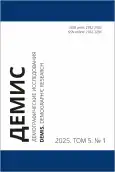DEMIS. Demographic Research
ISSN (print): 2782-2303, ISSN (online): 2782-229X
Publication frequency: quarterly. Founded in 2021
Editor-in-Chief: Sergey V. Ryazantsev, Corresponding Member of the RAS, Doctor of Economic Sciences
Deputy Editor-in-Chief: Evgeniya M. Moiseeva, Candidate of Economic Sciences
Publisher: IDR FCTAS RAS
Double-Blind Peer Review
Open Access
Included in the list of Higher Attestation Commission (VAK), Category K2
«DEMIS. Demographic Research / DEMIS. Demograficheskie Issledovaniya». On July 1, 2020, at the Federal Center of Theoretical and Applied Sociology of the Russian Academy of Sciences (FCTAS RAS) the Institute for Demographic Research (IDR) was established. The Institute is launching the publication of a new peer-reviewed scientific journal focused on current demographic and migration processes, primarily in the former Soviet Union and other regions of the world.
The complexity and dynamics of demographic and migration processes, the improvement of their research methods, the transformation of demographic and migration policy, the development of conceptual theories of demographic and migration behavior require constant study and informing the scientific community, governments and the general public. In addition, new challenges, such as global climate change, economic crises, and the COVID-19 pandemic, actualize the importance of studying the demographic and migration behavior of the population, the factors that determine them, and the consequences for the economy, politics, and the social sphere.
The mission of the journal is to develop fundamental theories, improve methods for studying demographic and migration processes, promote the results of heuristic empirical research in different regions of the world, provide scientific justification and expert support for demographic and migration policy.
The journal pursuits theoretical and applied research on the processes of population reproduction, fertility and reproductive behavior, mortality and self-preserving behavior of the population, migration behavior and migration trends at the global and regional levels, features of urbanization and transformation of the network of settlements, conceptual approaches, forms of implementation and international mechanisms for the implementation of demographic and migration policy in various regions and countries of the world.
Current Issue
Vol 5, No 1 (2025)
Articles
In Memoriam of Galina I. Osadchaya
Abstract
 6-8
6-8


 9-10
9-10


Historical demographics
Interest of Japanese Intelligence Agencies in Demographic Data about Russia in the Late 19th – Early 20th Centuries
Abstract
 11-25
11-25


Passport Statistics as a Source for the History of Migration in Russia (RSFSR) during the Second World War
Abstract
 26-39
26-39


Russian Pioneers of Virgin Lands from China: Re-Emigrants in Eastern Siberia in 1954–1955
Abstract
 40-53
40-53


Regional demographics
The Elderly Population of Bashkortostan: Socio-Demographic Characteristics, Mortality, and Migration Trends
Abstract
 54-75
54-75


Foreign Migrants and Criminal Activity in the Republic of Sakha (Yakutia)
Abstract
 76-101
76-101


Birth Rate in Russian Regions: Spatial Patterns at the Municipal Level
Abstract
 102-120
102-120


Foreign demographics
Demographic Dynamics in the People’s Republic of China
Abstract
 121-135
121-135


The Latest Trends of Russian-Speaking Tourism to Thailand
Abstract
 136-151
136-151


Demographic and migration policy
Student Family as a Key Area of the New National Project “Family”
Abstract
 152-166
152-166


Russian Labor Market and Foreign Workforce: Searching for Ways to Solve the Problem of Staffing Shortage
Abstract
 167-175
167-175


Approaches to Assessing Russia’s Migration Potential
Abstract
 176-192
176-192


Reviews and essays
Migration from Russia еo Kyrgyzstan: A Sociological Study
Abstract
 193-201
193-201


“Socio-Demographic Essays”: Multidimensionality of Demographic Processes in the Republic of Belarus
Abstract
 202-207
202-207












